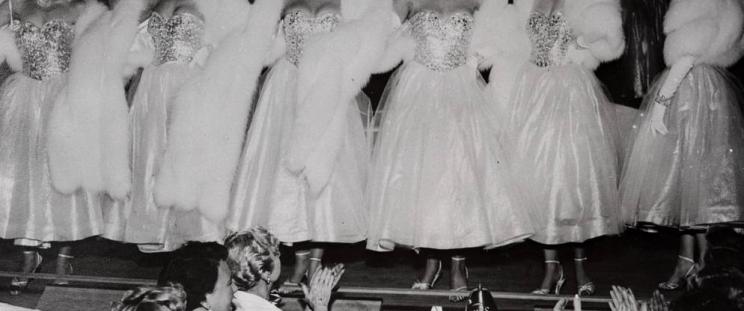Collection Paragraphs

Costumes and sets are an integral part of theatrical artistic expression. They are an art form as much as music and dance. Costumes combine color, texture, line, and shape, with the human form and its movement in the interplay of the lighting of the stage. Costumes set a mood and tone for a production.
Theatrical costuming is an extension or artistic projection of fashion, be it historical or an abstraction. The Las Vegas Show and the showgirl have become synonymous with extravagant costumes, extreme in their fashion and extreme in their setting of the female body.

These shows and designers established their own defining style. José Luis Viñas, Folco, Pete Menefee, Bill Hargate, and Bob Mackie, whose costumes for the big French shows of Donn Arden or Frederick Apcar, were international figures in the world of design. Lesser known designers like Josephine Spinedi, who designed for Harold Minsky and Matt Gregory, brought new styles within the context of the traditional showgirl. Spinedi who designed classic showgirl costumes also incorporated modern design and fashion into Matt Gregory’s smaller hip shows like Mad, Mod World, The Feminine Touch, and Pony Express. Most of the hotel dance lines were costumed, and changed costumes throughout the show. In many respects, and certainly for the less kinetic lines like the Copa Girls, the costumes and their display were the show. Even for the Donn Arden dancers their costumes often stole the show, and numbers became identified by the costume, not by the music. It reflected the tradition of modeling which formed an integral part of the elaborate French shows, of Ziegfeld’s follies, where statuesque women in ornate hats or headpieces stepped carefully down staircases, or used their accessories like feathered fans to produce an abstract choreographed visual effect.
The theater has always provided an outlet for fashion designers, and this was true for the Paris music halls, which drew the Parisian fashion world onto their stage. Much of this style derives from the Parisian nouveau aesthetic and high couture of the ‘20s defined by such artist-designers as “Erté” (Romain de Tirtoff), whose covers of Harper’s Bazaar and costumes and sets for the Paris Folies-Bergère expressed a stylized and fantasized costuming of the elegant ultra-chic woman for whom money was no object.

It was a style personified by the femme fatale of the pervasive Hollywood screen. It was the fin de siècle erotic decadence of Aubrey Beardsley, whose drawings and style clearly influenced Erté. As José Luis Viñas expressed it in a 1994 interview in Las Vegas Style, “The important thing to a costume is to make woman beautiful.” Designers like Erté, who designed for theater and film, were artists, much influenced by the trends in visual arts of their day. The Paris stage was a multidimensional gallery for the art avant-garde in set and costume design and music. Diaghilev’s Ballet Russe for example used sets designed by Picasso to complement the music being written by Erik Satie and Igor Stravinsky. The music halls and cabarets were similarly a place for the more bohemian avant-garde to experiment with new forms; the showgirl, while stereotypically garbed in boas, rhinestones, feathers, furs, and g-strings, also displayed the cut and style of contemporary outré fashion. Self-conscious decadence was an artistic tradition that formed the style of Las Vegas.
